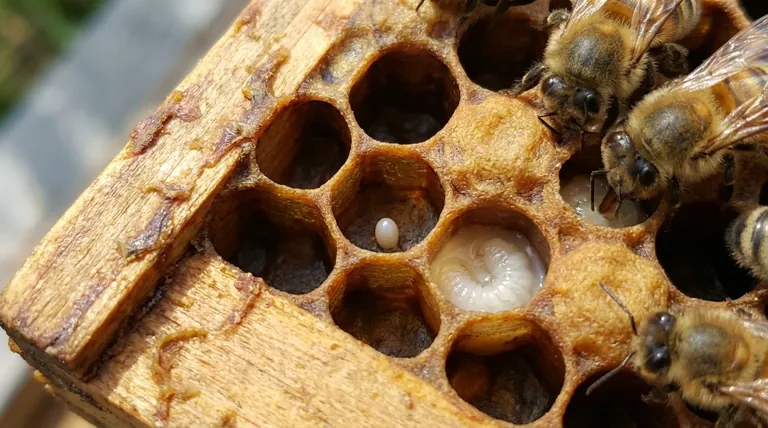From egg to a capped cell, the development of a honey bee progresses through three distinct stages: egg, larva, and pupa. This entire process, from the moment the egg is laid until the pupa is fully formed and sealed in its cell, takes approximately 10 days for a standard worker bee.
The transformation from a simple egg to a complex pupa is a highly structured process of metamorphosis. However, the exact timing is not universal; it is fundamentally dictated by the bee's future role, or caste, within the colony.

The Foundation: The Three Stages of Metamorphosis
The journey from egg to the pre-adult form involves a complete transformation, with each stage serving a distinct biological purpose. This process is known as complete metamorphosis.
Stage 1: The Egg (Days 1-3)
The queen bee lays a single, tiny white egg in each beeswax cell. For the first day, the egg stands upright. By the third day, it leans over and lies flat on the bottom of the cell, just before hatching.
During this entire phase, the cell remains uncapped, allowing worker bees to inspect the egg's viability.
Stage 2: The Larva (Days 4-9)
The egg hatches into a small, white, legless grub called a larva. This is the primary growth stage, where the larva's only job is to eat.
Worker bees feed the larva constantly, and its size increases dramatically over just a few days. Like the egg stage, the cell remains uncapped to allow for this continuous feeding.
Stage 3: The Pupa (Begins around Day 10)
Once the larva is fully grown, worker bees cover its cell with a wax capping. This signals the beginning of the pupal stage.
Inside the capped cell, the larva spins a cocoon and begins its transformation into a pupa. The pupa starts to develop the recognizable features of an adult bee, including eyes, legs, and wings.
A Critical Distinction: Development by Caste
While the sequence of stages is the same for all honey bees, the total time required to emerge as an adult varies significantly based on the bee's caste. This variation is crucial for the colony's social structure and survival.
The Worker Bee (21 Days Total)
This is the standard developmental timeline. The journey from egg to emerging adult worker bee takes approximately 21 days.
The Queen Bee (16 Days Total)
Queen development is accelerated. A specially selected larva is fed an exclusive diet of royal jelly, which triggers rapid growth and allows her to emerge as an adult in only 16 days.
The Drone Bee (24 Days Total)
Drones, the male bees of the colony, take the longest to develop. Their journey from egg to emerging adult takes a full 24 days.
Understanding the Implications
Each developmental stage has unique characteristics and vulnerabilities that are important for anyone observing a hive to understand.
The Uncapped Vulnerability
The egg and larval stages occur in open, uncapped cells. This makes them highly vulnerable to pests, diseases, and temperature fluctuations within the hive.
The Capped Transformation
Once the cell is capped, the pupa is protected from many external threats. However, this is also the primary reproductive site for pests like the Varroa mite, which feeds on the developing bee while hidden under the capping.
The Energetic Cost
The rapid growth of larvae requires an immense amount of resources. A healthy, growing colony must have a strong workforce of forager bees bringing in a constant supply of pollen and nectar to feed its young.
How to Apply This to Hive Inspection
Understanding this lifecycle allows you to read the story of a colony by observing its brood frames.
- If your primary focus is identifying a healthy queen: Look for tiny, white eggs standing upright, which confirms she was actively laying within the last three days.
- If your primary focus is assessing colony strength: A healthy brood pattern with eggs, larvae of various sizes, and capped pupa cells indicates the colony is growing steadily.
- If your primary focus is managing pests: Recognizing the capped pupal stage is essential, as this is when pests like Varroa mites reproduce, influencing the timing of treatments.
By understanding these distinct stages, you can decode the health, strength, and future of any honey bee colony.
Summary Table:
| Stage | Duration (Worker Bee) | Key Characteristics |
|---|---|---|
| Egg | Days 1-3 | Laid by queen; cell remains uncapped. |
| Larva | Days 4-9 | Feeding and growth stage; cell remains uncapped. |
| Pupa | Begins ~Day 10 | Cell is capped; transformation into adult bee occurs. |
Master your hive inspections with the right equipment. Understanding bee development is key to managing colony health. For commercial apiaries and distributors, having reliable, high-quality supplies is non-negotiable for success. HONESTBEE provides the essential beekeeping supplies and equipment you need to support healthy brood development and strong colonies. Let's discuss your wholesale needs – contact our team today to get the right tools for your operation.
Visual Guide

Related Products
- Electric Flatting and Embossing Machine with Tray for Beekeeping
- Professional Galvanized Hive Strap with Secure Locking Buckle for Beekeeping
- HONESTBEE Durable Frame Wiring Board with Integrated Tensioner
- Nicot Queen Rearing Kit for Beekeeping and Grafting in Nicot System
- Mesh Ventilated 3 Layer Goatskin Beekeepers Gloves for Beekeeping
People Also Ask
- What is the importance of soaping the rollers during milling? Prevent Wax Adhesion & Equipment Downtime
- What customization options are available with fully automatic wax foundation machines? Tailor Sheets for Any Hive Frame
- What tools are used to add intricate details to beeswax sheets? Find the Right Embossing Method for Your Scale
- What qualities are important for someone starting in beekeeping? Build a Thriving Apiary with the Right Mindset
- What are the main methods of honey extraction? Optimize Your Harvest for Maximum Yield



















